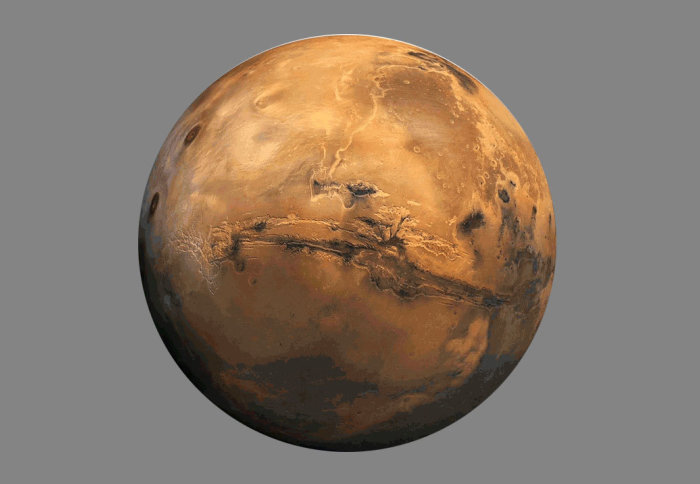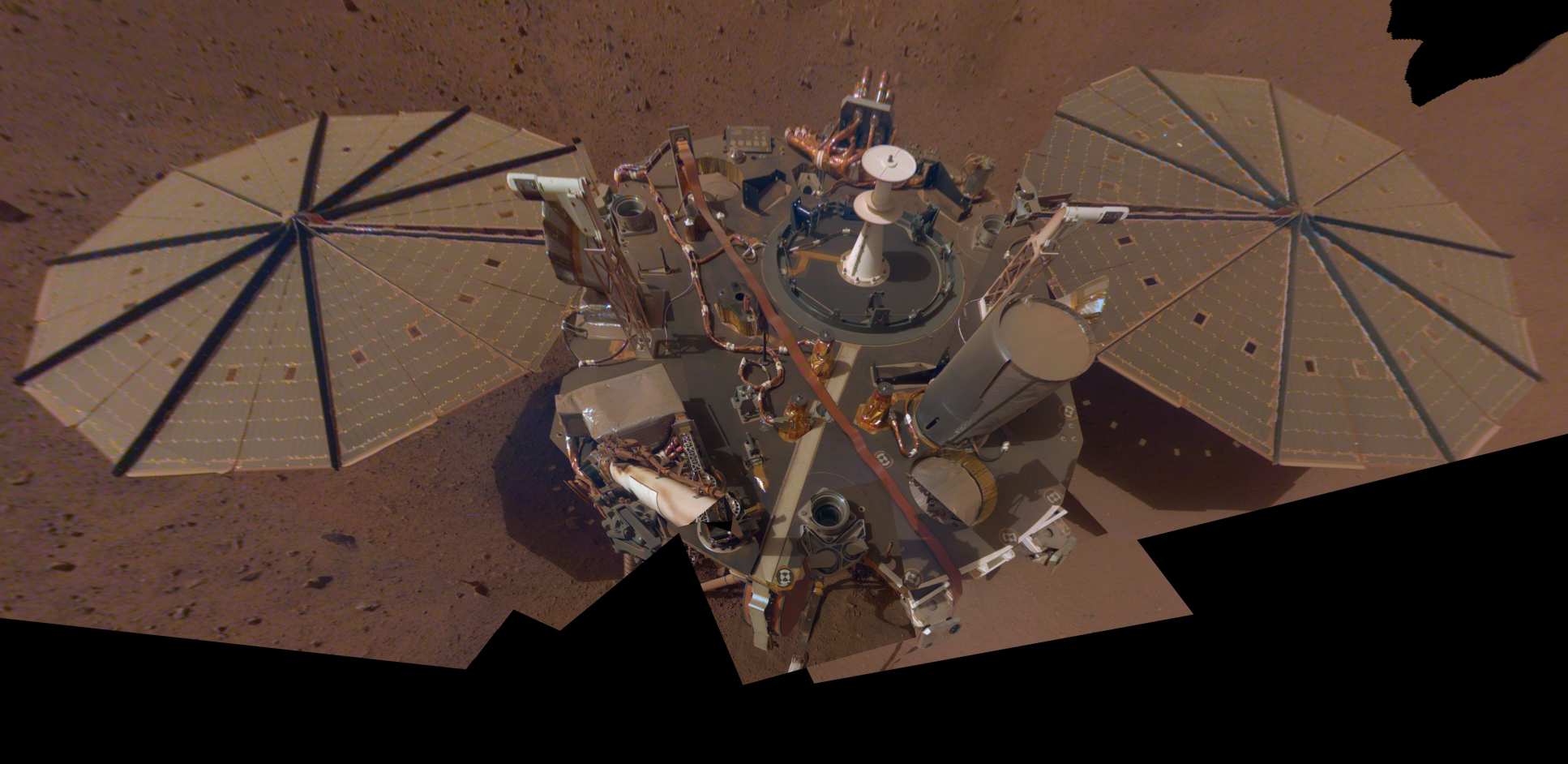Quakes, dust devils and midnight magnetic pulses: findings from a year on Mars

The Imperial-designed sensor onboard Mars InSight has so far detected over 400 earthquakes on the Red Planet, according to new research in Nature.
Detecting hundreds of marsquakes on a planet 140 million miles from Earth, using sensors developed in the UK, is an important achievement. Amanda Solloway UK Science Minister
An international team of scientists led by NASA created Mars InSight, the first mission to study the deep interior of Mars, to generate unprecedented data about the planet's inner structure.
Launched in May 2018, the lander touched down on the Red Planet on 205 days and 301 miles later, in November.
Now, a series of new papers published in Nature has provided an update on InSight’s work during its first year of operation, including that of the Imperial-built seismometer.
They revealed that Mars trembles more often, but also more mildly, than expected.
UK Science Minister Amanda Solloway said: “Detecting hundreds of marsquakes on a planet 140 million miles from Earth, using sensors developed in the UK, is an important achievement.
“This is an example of how world-leading UK science and our growing space sector contribute to international missions, furthering human understanding of the Solar System.”
Trembling terrain
Our current understanding is that tectonic activity supports biological activity, with plate tectonics creating a way to mix the atmosphere and the interior of our planet. What we have found confirms that link has been broken on Mars Professor Tom Pike Department of Electrical and Electronic Engineering
Onboard InSight is a seismometer that detects tremors, or ‘Marsquakes’, below the Martian surface. Imperial College London’s Professor Tom Pike led the team that designed and built the seismometer, known as the Seismic Experiment for Interior Structure (SEIS).
The new papers reveal that Mars trembles more often, but also more mildly, than expected. SEIS has found more than 400 seismic signals to date, the vast majority of which are probably quakes (as opposed to signals created by the environment, like wind). The largest quake was about magnitude 4.0 in size — not quite large enough for the shock waves to travel down to the lower mantle and core.
Professor Pike, of Imperial's Department of Electrical and Electronic Engineering, said: “From the tremors, we can build a picture of Mars’ interior and help us detect a solid or liquid core. The remains of a liquid core could suggest that Mars once had a magnetic field. Like on Earth, the field would have protected it from harmful solar winds billions of years ago. Back then, Mars then was much warmer and wetter, and might have been capable of harbouring early life.
“All our seismic instruments have been operating perfectly, surpassing their requirements. We can pick up motion that shakes the ground below us by less than an atom’s width. This is fortunate as Mars has turned out to be seismically pretty quiet and we have to pick up every tremor.
“With what we’ve seen so far it looks like Mars has a similar level of seismic activity to the UK. The contrast between Earth and Mars is stark: while here tectonic activity is still building mountains, on Mars we’re seeing the remnants of the forces that shaped the planet in the past.
“Our current understanding is that tectonic activity supports biological activity, with plate tectonics creating a way to mix the atmosphere and the interior of our planet. What we have found confirms that link has been broken on Mars.”
At the surface
Studying Mars lets us travel to the solar system’s ancient past. Professor Tom Pike Department of Electrical and Electronic Engineering
Billions of years ago, Mars probably had a magnetic field that is no longer present. But it left ghosts behind: this field magnetised ancient rocks that are now up to several miles below ground. InSight is equipped with a magnetometer — the first on Mars — to detect magnetic signals at the surface.
The magnetometer has found that these signals at Homestead Hollow – where InSIght landed – are ten times stronger than predicted by data from orbiting spacecraft that have studied the area. The measurements of these orbiters are averaged over a couple of hundred miles, whereas InSight's measurements are more local.
Because most surface rocks at InSight's location are too young to have been magnetised by the planet's former field, this magnetism must be coming from ancient rocks underground, according to Dr Catherine Johnson, a planetary scientist at the University of British Columbia and the Planetary Science Institute.
She said: "We're combining these data with what we know from seismology and geology to understand the magnetised layers below InSight. How strong or deep would they have to be for us to detect this field?"
InSight has also detected mysterious magnetic pulses, typically around midnight, which are currently unexplained.

In the wind
InSight's weather sensors have detected hundreds of passing whirlwinds, which are called dust devils when they pick up grit and become visible.
Despite all that activity and frequent imaging, InSight's cameras have yet to see dust devils. But SEIS can feel these whirlwinds pulling on the surface like a giant vacuum cleaner.
Still to come: the core
InSight has two radios: one for sending and receiving data, and a more powerful radio designed to measure the ‘wobble’ of Mars as it spins. This X-band radio, also known as the Rotation and Interior Structure Experiment (RISE) can eventually reveal whether the planet's core is solid or liquid. A solid core would cause Mars to wobble less than a liquid one would.
Professor Pike said: “Studying Mars lets us travel to the solar system’s ancient past. While Earth and Venus' tectonic systems have destroyed most of the evidence of their early history, much of the Red Planet has remained static for more than three billion years.”
The researchers say this first year of data is just a start. Monitoring over a full Martian year (two Earth years) will give scientists a much better idea of the size and speed of the planet's wobble.
This story was adapted from a press release by NASA Jet Propulsion Laboratory.
Professor Pike, Principal Investigator of the UK’s contribution to InSight, worked under funding from the UK Space Agency.
The silicon microseismometers were designed and built at Imperial's Department of Electrical and Electronic Engineering.
The integration and electronics provided by the Department of Physics at Oxford University.
The UK contribution is part of the SEIS instrument built by a European team and delivered by CNES to NASA’s Jet Propulsion Laboratory, which is leading the InSight mission.
Credits:
Main image & GIF: NASA/JPL-Caltech/ETH Zurich/ Van Driel
Selfie image: NASA/JPL-Caltech
Article supporters
Article text (excluding photos or graphics) © Imperial College London.
Photos and graphics subject to third party copyright used with permission or © Imperial College London.
Reporter
Caroline Brogan
Communications Division